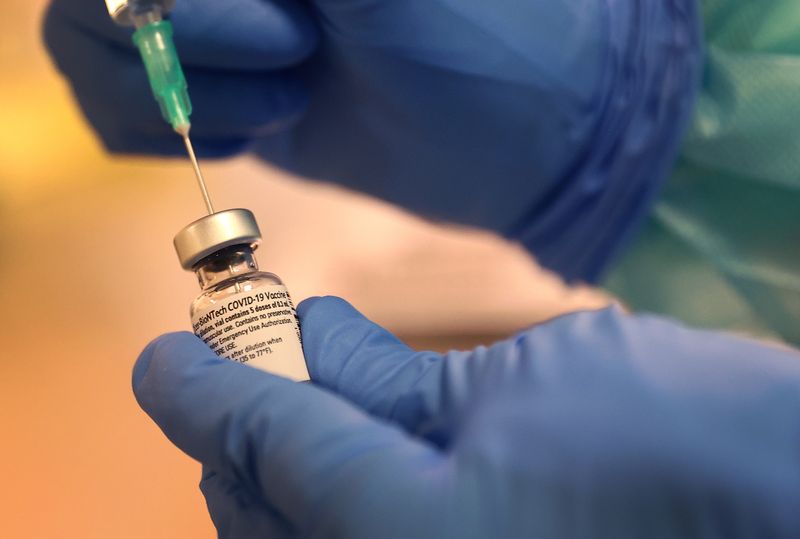(This Jan. 10 story corrects paragraph 16 to say Pfizer and BioNTech halved 2020 output forecast in November, not December)
BERLIN/DILLENBURG, Germany (Reuters) – Proud of their national reputation for efficiency, Germans are growing increasingly frustrated by the slow rollout of a COVID-19 vaccine its scientists helped develop.
Scarce vaccine supply, cumbersome paperwork, a lack of healthcare staff and an aged and immobile population are hampering efforts to get early doses of a vaccine made by U.S.-based Pfizer and German partner BioNTech into the arms of the people.
Germany has set up hundreds of vaccination centres in sports halls and concert arenas and has the infrastructure to administer up to 300,000 shots a day, Health Minister Jens Spahn said.
But the majority are standing empty, with most states not planning to open centres until mid-January as they prioritise sending mobile teams into care homes.
A day spent with a vaccination team in the small town of Dillenburg, 100 km (60 miles) to the north of Germany’s financial capital Frankfurt, shows just how painstaking the task is.
The team starts out by loading a cool-box containing 84 doses of the Pfizer vaccine defrosted overnight into a waiting ambulance, and setting out for the Elisabeth residential care home.
There they are met by manager Peter Bittermann, who has already dealt with the forms needed to vaccinate residents and staff, and provided space for the shots to be administered and recipients monitored post-vaccination.
The four-member immunisation team, plus two trainees, has just a few hours to dispense the temperature-sensitive Pfizer vaccine before it is no longer fit for use.
The German Red Cross needs an extra 350 people to run its local vaccination campaign, said Nicole Fey, spokeswoman of the local district administration.
“We’ve been able to recruit some, but there can never be enough,” she told Reuters TV.
GERMANY LAGS
In the first two weeks of its vaccination drive Germany has given 533,000 shots, just two-fifths of the 1.3 million doses received. Britain, by contrast, has reached the 2 million mark.
Israel, the world leader in terms of the share of population covered, is inoculating 150,000 people daily, with its universal and digitally enabled healthcare system making it easier to schedule appointments.
Germany’s larger size and federal set-up are complicating operations, a problem also faced in the United States.
Elsewhere in Europe, the decentralisation of Spain’s vaccination operation has exposed differences between regions and led to tensions with the central government.
Graphic: COVID-19 vaccine doses administered – https://graphics.reuters.com/HEALTH-CORONAVIRUS/xegpbbernpq/chart.png
Germany’s 16 states blame the federal government for not securing enough doses. Doctors in some centres say shifts have been cancelled. In Berlin, one vaccination centre was opened, only to be closed over New Year due to a lack of shots.
Spahn says manufacturing problems rather than too few orders are to blame for the limited supply, after Pfizer and BioNTech in December halved their production forecast to 50 million doses by year-end. Each recipient requires two shots..
The government is working with BioNTech to open a new production site in the western town of Marburg, he said. BioNTech’s chief executive said last week the Marburg plant may enter service in February, ahead of schedule.
“With the capacity we have already created in Germany, we will be able to carry out between 250,000 and 300,000 vaccinations per day – when we have the vaccine doses,” Spahn said this week.
Germany expects to receive 5.3 million shots from Pfizer/BioNTech by mid-February and another 2 million doses of a second vaccine from Moderna, just approved by the European Union, by the end of March.
Yet this will barely be enough to cover the 5.7 million people, or 6.8% of the population, aged over 80.
THE LAST MILE
As in Spain, state-by-state performance in Germany varies widely. Top of the class is Mecklenburg-Vorpommern in the north, with 15.6 vaccinations per 1,000 residents, while Saxony has a rate of just 4.4.
In Thuringia, another laggard, state premier Bodo Ramelow said on Tuesday that many doses sent to hospitals had been returned. “If the brakes come on at a vaccination rate of 30 or 33%, we have a real problem,” he told Deutschlandfunk radio.
In Saxony, the social affairs ministry said missing consent forms, challenges with route planning, COVID outbreaks in homes and last-minute cancellations had slowed its rollout.
Shots in Saxony were stored centrally until recently, meaning mobile teams had to drive long distances before heading to care homes.
In contrast to Dillenburg, Saxony has been overrun by people volunteering for its vaccination drive, said Lars Werthmann, regional logistics chief at the German Red Cross.
“The next mammoth task is to coordinate all these people,” Werthmann said.
Doctors meanwhile express frustration at appointment booking systems that vary from state to state, saying they cause confusion and erode trust.
To speed up the rollout of COVID-19 shots, Germany should distribute them through its network of family doctors’ practices as soon as there is a vaccine that can be easily stored in a fridge, said Berlin paediatrician Burkhard Ruppert.
Germany is hoping to administer shots at doctors’ practices in a second phase.
“Our strength in Germany is this outpatient care system,” said Ruppert, who heads a local doctors’ association. “We’re not a country of large-scale managed systems like the United Kingdom or Israel might be.”
“We are in a race against a virus,” he added. “We will only win if we vaccinate as much and as fast as possible.”
(Reporting by Caroline Copley in Berlin and Annkathrin Weis in Dillenberg; Additional reporting by Emma Pinedo Gonzalez in Madrid and Nadine Schimroszik in Berlin; Editing by Douglas Busvine and Jan Harvey)






















